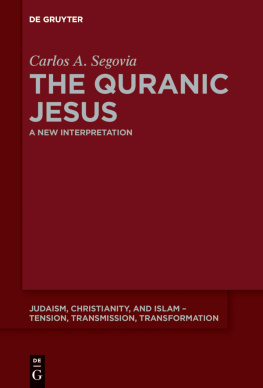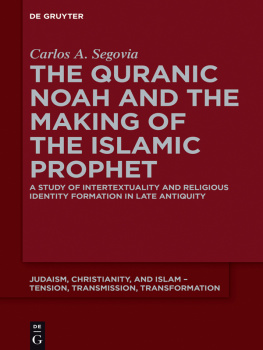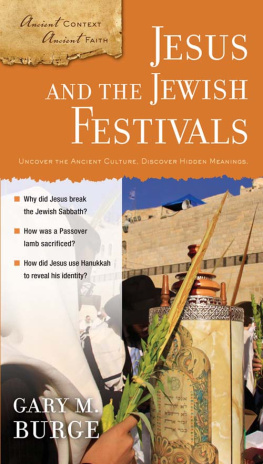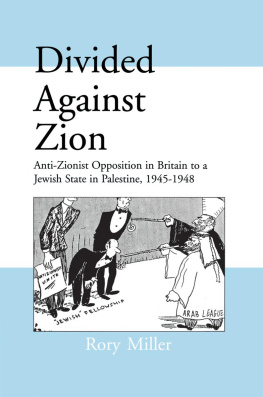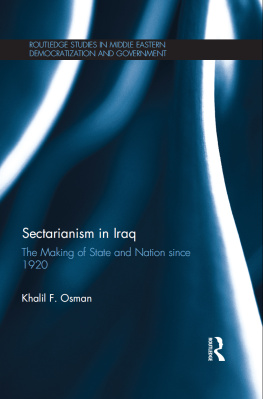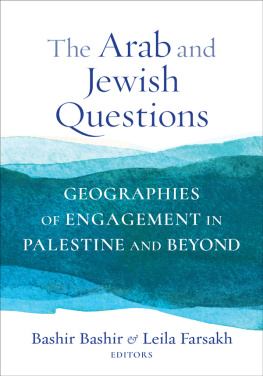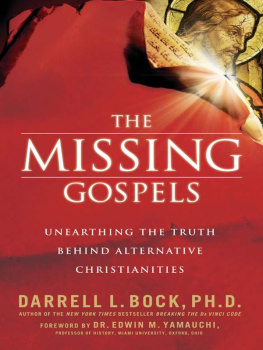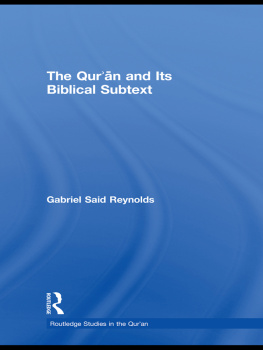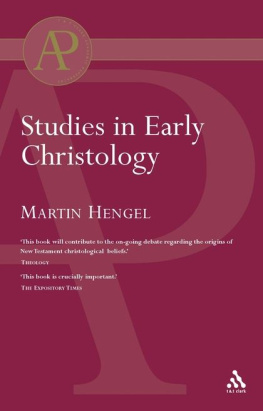Contents
Guide

Carlos A. Segovia
The Quranic Jesus
Judaism, Christianity, and Islam Tension, Transmission, Transformation

Edited by Patrice Brodeur, Alexandra Cuffel, Assaad Elias Kattan, and Georges Tamer
Volume 5

ISBN 978-3-11-059764-6
e-ISBN (PDF) 978-3-11-059968-8
e-ISBN (EPUB) 978-3-11-059896-4
ISSN 2196-405X
Library of Congress Control Number: 2018951346
Bibliografic information published by the Deutsche Nationalbibliothek
The Deutsche Nationalbibliothek lists this publication in the Deutschen Nationalbibliografie; detailed bibliografic data are available on the Internet at http://dnb.dnb.de.
2019 Walter de Gruyter GmbH, Berlin/Boston
www.degruyter.com

To Sofya

Preface
While clearly affirming that God has no partner, and moreover that he is childless, the quranic authors repeatedly encourage their audience to behave like Jesuss disciples, defend Jesus against the Jews, declare him to be the Messiah and the Word of God as well as a spirit from him (a series of titles they never apply to other prophets), make systematic use of a number of crucial Christian rhetorical moves, and quote more or less verbatim the New Testament Apocrypha and the writings of several late-antique Christian authors. Furthermore, they seem to be engaged in intra-Christian controversies just as much as they seem to partake in anti-Christian polemics. Conversely, the apparently pro-Jewish passages that one finds in the Qurn often prove tricky, as they are usually placed within, or next to, more or less violent anti-Jewish pericopes that bear the marks of Christian rhetoric despite a few occasional anti-Christian interpolations. And to further complicate the matter, the earliest quranic layers seem to develop a high- yet non-incarnationist Christology of which, interestingly enough, Jesuss name is totally missing.
What, then, can we make out of this puzzle? To what extent may the Qurns highly complex Christology help to decipher not only the intent of various quranic authors which may well be very different from what has been hitherto taken for granted but also the likewise complex redactional process characteristic of the document itself? Is it, moreover, possible to inscribe the often indeed too-often oversimplified Christology of the Qurn within the peripheral religious culture of the 6th-to-7th-century Near East? Is it possible, also, to unearth from it something about the tension carefully or perhaps not so carefully buried in the document between a messianic-oriented- and a prophetic-guided religious thought, and to root therein the earliest Islamic schism if speaking of Islam before Abd al-Maliks reign in the late 7th century makes any sense, that is? By analysing, first, the typology and the plausible date of the Jesus-texts contained in the Qurn (which implies moving far beyond any purely thematic division of the passages in question), and by examining, in the second place, the Qurns earliest Christology vis--vis its later (and indeed much better known) Muhamadan kerygma , the present study tries to give response to these crucial questions.
. Above all, however, I should like to express my deepest gratitude to my wife, Sofya, without whose generous inspiration and precious love I would be unable to breathe and think; dedicating this book to her is but a humble sign of my devotedness to whom I feel blessed to live with every day.
Abbreviations
| AIBL | Acadmie des Inscriptions et Belles-Lettres |
| AIG | Arabic Infancy Gospel |
| ANZM | Administration der Neuen Zeitschrift fr Missionswissenschaft |
| apud | At, in the writings of |
| Arab. | Arabic |
| ASA | Ancient South Arabian |
| ASMEA | Association for the Study of the Middle East and Africa |
| b . | Babylonian Talmud |
| BEHE | Bibliothque de lcole des Hautes tudes |
| BEHESR | Bibliothque de lcole des Hautes tudes Sciences Religieuses |
| BHMIIS | Bulletin of Henry Martyn Institute of Islamic Studies |
| BJQHS | Al-Bayn: Journal of Qurn and adth Studies |
| BJRL | Bulletin of the John Rylands Library |
| BRLJ | Brill Reference Library of Judaism |
| BSOAS | Bulletin of the School of Oriental and African Studies |
| c. | Around (Latin: circa ) |
| C1 | Christology no. 1 |
| C2 | Christology no. 2 |
| C3 | Christology no. 3 |
| CCL | Collection Cerfaux-Lefort |
| CESIF | Cultures on the Edge: Studies in Identity Formation |
| cf. | Compare (Latin: confer ) |
| ch(s). | Chapter(s) |
| CIH | Corpus Inscriptionum Himyariticarum |
| contra | In opposition or contrast to |
| CRSAIBL | Comptes rendus des sances de lAcadmie des Inscriptions et Belles-Lettres |
| CSAI | Corpus of South Arabian Inscriptions |
| CT | Cave of Treasures |
| CTh | Cahiers thologiques |
| CUASEC | Catholic University of America Studies in Early Christianity |
| d. | died |
| DA | Diskurse der Arabistik |
| DACS | Dissertations: Ancient Christian Studies |
| DAI | Deutsches Archologisches Institut |
| DHR | Dynamics in the History of Religions |
| DOP | Dumbarton Oaks Papers |
| DORLC | Dumbarton Oaks Research Library and Collection |
| DR | Dublin Review |
| DRLAR | Divinations: Rereading Late Ancient Religion |
| ECCA | Early Christianity in the Context of Antiquity |
| ECS | Easter Christian Studies |
| ed(s). | Edited by, editor(s) |
| e.g. | For example (Latin: exemplum gratia ) |
| EI | Encyclopaedia of Islam |
| EME | ditions Modulaires Europens |
| 1 En | 1 Enoch |
| EnIr | Encyclopaedia Iranica |
| esp. | especially |
| EUS | European University Studies |
| GDN | Grosser Damm Nord |
| Gk. | Greek |
| Heb. | Hebrew |
| HR | History of Religions |
| HTR | Harvard Theological Review |
| i.e. | That is (Latin: id est ) |
| IFD | Institut Franais de Damas |
| IISMM | Institut dtudes de lIslam et des socits du monde musulman |
| IJHCME | Der Islam: Journal of the History and Culture of the Middle East |

